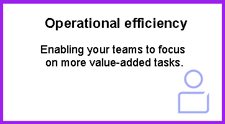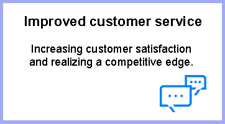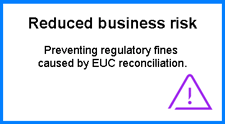Tactical vs strategic reconciliation
Whilst your organization will have a wide ranging, systemic, strategic reconciliations infrastructure covering the business-as-usual requirements of the firm, there will be times when business users require a tactical, efficient, and convenient reconciliation tool to solve a business need. This may sometimes be to facilitate a new business line prior to incorporating the reconciliation into the enterprise system, but often it is to deal with the infrequent or edge-case scenarios that are difficult to justify as systemic build items.
We understand that identification, requirement gathering, business case creation, build and deployment, including user acceptance testing and regression testing, can be onerous for both business lines and internal IT departments.
Often a business adopts End User Computing (EUC) as a solution to respond quickly to changing business needs. However, EUCs represent a risk.
EUCs, also known as End User Development (EUD), can be defined as custom applications created by end users without IT involvement. These applications include Excel macros, Microsoft Access databases, and Visual Basic for Application (VBA) code, designed to enable users to automate manual repetitive tasks quickly, such as performing data transformation, reconciliation, and reporting activities.
What are the risks?
Significant manual operational effort is required to gather, document, validate and report data on EUC/D’s to regulators who are becoming less forgiving about the change control and audit functions for these reconciliations. For example, the EU's General Data Protection Regulation (GDPR) imposes strict rules on the collection, storage, and processing of personal data, which makes monitoring of EUCs vital.
EUC applications present a significant risk to your business if they are not managed properly. The end users who are performing reconciliations on spreadsheets are often unaware of rules around personal information handling, potential for data breaches, and approval processes to maintain them. EUCs expose your organization to cyber-attacks, including malware and phishing that can compromise sensitive data.
Where do we begin?
Identify the different types of reconciliations that are maintained within your company that do not have appropriate safeguards, such as audit log and change-control protocols.
Select a flexible solution that empowers business users to onboard and configure existing reconciliations enterprise-wide.
Prioritize the non-systemic reconciliations that have significant financial, operational, and reputational risks associated with them.
Plan a timeline to migrate EUC/EUD-driven reconciliations across your company and identify the role of key stakeholders.
Implement procedures to assess and execute new reconciliations on controlled platforms.
Maintain an inventory of all EUCs implemented across the firm.
What are the challenges?
EUCs can perform poorly and are difficult to scale to large volumes of data. The cost associated with onboarding or being unable to handle the complexity and size of a reconciliation, encourages end users to continue to perform non-standard reconciliations on spreadsheets. This approach is inefficient, and unsustainable, and severely exposes firms to multiple risks.
Data quality is key. Incomplete, inaccurate, or inconsistent data results in errors, delays, and incorrect decisions. Data preparation or collection, scraping emails, uploading, and mapping files is often performed in a non-consistent way with no validation or evolving techniques for new data sources.
Manual processing is vulnerable to human error. However, when the process is in a EUC/D application it is often difficult to identify and track user changes. A lack of end-to-end reconciliation, process documentation, and version control, make it difficult for owners to share or pass on the reconciliation.
Onboarding new or expanding existing reconciliations quickly and efficiently can be a challenge for operations teams. An ideal onboarding process should take days, not months. Existing solutions require the help of IT, increasing onboarding time.
Enterprise vs single solution?
Taking control of EUCs is essential to the success of your business. An enterprise-wide, automated reconciliation solution helps your organization to manage EUCs across entities, and provides a control framework to automate non-standard, unstructured, and EUC-style reconciliations on a single platform.
This enterprise-wide approach to managing EUC reconciliations is beneficial as it involves a clear strategy, key stakeholders, IT governance, and technology, and covers all aspects of managing EUCs in a controlled environment.
An enterprise-wide automated reconciliation solution improves data accuracy, enabling data extraction from multiple sources and document formats. Automation also improves operational efficiency, delivering a faster service for a superior customer experience.
A tactical single solution approach delivers end-to-end EUC reconciliation capabilities. Including integration with existing and new systems, validation and enrichment of data in preparation for a reconciliation, centralized version control, standardized workflow, audit log with user permissions, and advanced reporting capabilities to send the data to downstream systems, or to meet internal and regulatory reporting requirements.
Return on investment (ROI)
An ROI is quickly realized by migrating and managing existing reconciliations onto a single enterprise-wide platform, with key benefits including:



Contact us today to learn more about our reconciliation solution.



